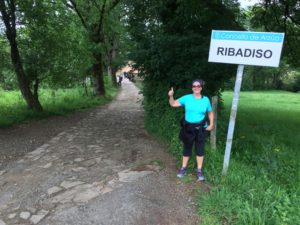Both Leah and I had vivid memories of the events of Day 3 during our 2017 pilgrimage to Santiago de Compostela. It was a difficult day for both of us, for different reasons, and both of us had to overcome some trepidation. And did.
What was curious about the events of yesterday?
Each of us feared the walk for reasons that never really existed. Our memories were faulty. Our recollection of what went wrong — and what might go wrong — was flawed.
And now we have another leg of the walk to Santiago behind us.
Leah had a physical and emotional crisis late in the 30-plus kilometer (18.6 miles) walk from Palas de Rei to Arzua last year.
She ran out of energy. Easy as that. She crossed a bridge over a little rushing river near the hamlet of Ribadiso … and as she looked up at another hill … her body pretty much quit working.
She was cramping and exhausted during one of the longest Camino de Frances walks west of the Pyrenees Mountains.
We arrogantly thought we could march 30 kilometers, and then we made a bad mistake by deciding we could do it without lunch.
Bodies do not work well in those kinds of conditions. About seven hours into the hike, she had no energy left and had trouble moving at all, and felt defeated, but also was determined not to quit.
She was a few yards behind me when she ran out of gas, and after some tears but steady resistance to admitting defeat, I convinced her to have some water and eat a Snickers bar (my solution for almost any energy-sapping moment) and she slowly but steadily made her way forward.
She was worried as we approached the same picturesque bridge and town this year, but breakfast had been only four hours before, and our walk was more realistic/shorter, thanks to a friend’s insistence, and Leah summoned the determination to make it.
An interesting aspect to this? She was on the verge of collapse, a year ago, and her recollection of the events during and after the crisis varied significantly from what actually happened — which she learned after we crossed the bridge for the second time.
Her memory was that she had several hills to climb and dragged herself for two hours, following her “bonking” moment, before reaching the destination town of Arzua.
In fact, she had one significant hill to climb, and then about 200 yards to negotiate — until we could see Arzua. Her brain, a little fried in April last, gave her a memory worse than it was — she had been only about 25 minutes from the finish.
This time? She sailed through it, and was very pleased.
For me, my memory, laid out ahead of the walk in the previous blog post, pertained to hill climbs.
My faulty memory was that the final kilometers were jammed with long climbs up to ridges followed by jolting, stumbling declines down the back side. One after another after another.
I was sure there were at least five climbs like that. Maybe more. And, at my age, and not as fit as I hoped to be ahead of the walk, I was concerned that I would not so much knock out those climbs … as that they would knock out me.
My brain gave me bad information, also. All those climbs? More like four than six or seven. And they were not as steep as my tired mind, of April 2017, told me, and I took counsel of my fears — or my marred recollections.
The climb out of the Ribadiso Valley was the last of the climbs. It was a challenge but not the death-defying event I recalled.
Oh, and that morning rain we had, back in the town of Melide? It quit before we got on the trail.
Everything went well. And the Ribadiso Valley can now be a pleasant memory for each of us, instead of a bete noire.
Within half an hour, we were sitting at a sidewalk cafe having a sandwich and a Spanish tortilla and some of the local cheese with quince jam — and a couple of Estrella beers. Not long after, our friends came up the street and joined us. All was good again, and we felt thankful.


0 responses so far ↓
There are no comments yet...Kick things off by filling out the form below.
Leave a Comment